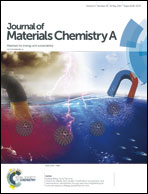MOF-derived yolk–shell CdS microcubes with enhanced visible-light photocatalytic activity and stability for hydrogen evolution†
Abstract
Yolk–shell structures with a unique three-dimensional (3D) open architecture offer great advantages for constructing advanced photocatalysts. However, metal sulfides with yolk–shell nanostructures were rarely reported. In this work, unique yolk–shell CdS microcubes are synthesized from Cd–Fe Prussian blue analogues (Cd–Fe-PBA) through a facile microwave-assisted hydrothermal process. Their formation mechanism is also proposed based on the anion exchange and Kirkendall effect process. Benefitting from structural merits, including a 3D open structure, small size of primary nanoparticles, high specific surface area, and good structural robustness, the obtained yolk–shell CdS microcubes manifest excellent performances for photocatalytic hydrogen evolution from H2O under visible-light irradiation. The photocatalytic H2 evolution rate is 3051.4 μmol h−1 g−1 (with an apparent quantum efficiency of 4.9% at 420 nm), which is ∼2.43 times higher than that of conventional CdS nanoparticles. Furthermore, the yolk–shell CdS microcubes exhibit remarkable photocatalytic stability. This work demonstrates that MOF-derived yolk–shell structured materials hold great promise for application in the field of energy conversion.



 Please wait while we load your content...
Please wait while we load your content...